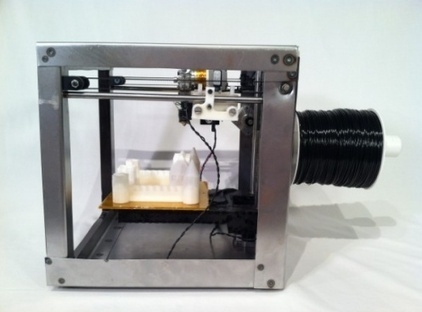3D printers could possibly be a revolutionary tool in the new era of technology. Many people are complaining that technology turns us from producers into consumers; we simply consume content instead of making it ourselves. But 3D printers are doing quite the opposite; start-ups or even ordinary people with good ideas can easily make their ideas real or make inexpensive prototypes without commissioning factories to do it for thousands of dollars. But there's been one reason why 3D printers haven't been making as much of a change in the world as they could be; they're too expensive.
The MakerBot replicator was considered unique and amazing when it hit the market, but its $1,999 price tag prevented it from reaching the mainstream audience. If you wanted, you could get MakerGear Mosaic 3D printer for $700, a kit that lets you assemble the printer yourself. But think of the time it takes to assemble the printer (at least a week), and the fact that you could ruin the printer if you assembled it incorrectly, and suddenly you're not headed right to their website to buy one.
But finally, a small startup in Brooklyn has achieved what most consumers would consider impossible knowing the price tags of similar items; breaking the $500 mark with a 3D printer. The printer is called the Solidoodle 2, and it could easily be a game changer for DIY people.
When I see something like this, my natural reaction is to look for the catch. So that's what I did. But amazingly, there's isn't one. As for size, it's 6"x6"x6" cube; while that's slightly smaller than the 8.9"x5.7"x5.9" MakerBot, but its size beats the 5.5"x5.5"x5.5" 3D Systems cube. Sure, printing is slightly harder (it can't print over Wi-Fi and doesn't have an SD card reader like the other two), but that isn't a big problem. And while it doesn't have a heated build platform (which helps keep the object in place during printing), the Pro model includes that for just $50 extra. The Expert model is $599, and it has the heated build platform and a metal and acrylic outer enclosure.
As for software, it uses Pronterface (above) and Skeinforge for controlling the printer and loading the prints. While it is relatively easy to make designs on these softwares, reorienting and rescaling prints isn't as easy. However, you can make designs on any software as long as you convert the file to STL format.
The Solidoodle 2 is currently on sale at Solidoodle's website. So now, finally, your ideas can be transformed into real, tangible objects. And you don't have to pay thousands of dollars for them.



